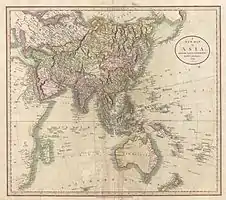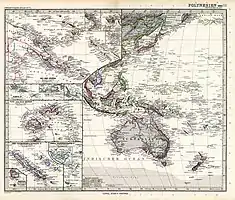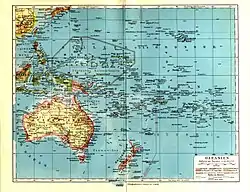Los Jardines
Los Jardines or Los Buenos Jardines[2] (Spanish for "the good gardens") are phantom islands supposedly located northeast of the Mariana Islands.
The islands were reportedly visited by Spanish explorers Álvaro de Saavedra Cerón (who named them Los Buenos Jardines) in 1528 and Ruy López de Villalobos (who called them Los Jardines) in 1542.[3][4][5] Sighted again by John Marshall in 1788,[1] they were purported to be part of an Anson Archipelago, which included other phantom islands such as Ganges Island as well as real islands such as Wake and Marcus Islands. In 1973, the International Hydrographic Organization removed them from its charts.[2]
Maps showing Los Jardines
 An 1806 British map showing two possible locations of (Los) Jardines northeast of the Mariana Islands
An 1806 British map showing two possible locations of (Los) Jardines northeast of the Mariana Islands An 1891 German map showing Los Jardines (Marshall) in the Anson Archipelago, northeast of the Mariana Islands and northwest of the Marshall Islands
An 1891 German map showing Los Jardines (Marshall) in the Anson Archipelago, northeast of the Mariana Islands and northwest of the Marshall Islands_MAP_OF_OCEANIA_-_comp._by_Irvine.jpg.webp) An 1899 British map showing Los Jardines northeast of the Marianas and northwest of the Marshalls
An 1899 British map showing Los Jardines northeast of the Marianas and northwest of the Marshalls A 1932 German map showing northeast of the Marianas and northwest of the Marshalls
A 1932 German map showing northeast of the Marianas and northwest of the Marshalls
References
- International Hydrographic Review, Volume 67. 1990. p. 165.
- "These Imaginary Islands Only Existed on Maps". 2017-12-09. Retrieved 2018-03-09.
- Stommel, Henry (1984). Lost Islands: The Story of Islands That Have Vanished from Nautical Charts. Vancouver: University of British Columbia Press. pp. 10–15. ISBN 0-7748-0210-3.
- Francis X. Hezel. The First Taint of Civilization: A History of the Caroline and Marshall Islands in Pre-colonial Days, 1521-1885. University of Hawaii Press, 1994. ISBN 9780824816438 P. 16: "The island group, which the Spaniards called Los Jardines,...cannot be identified with certainty, but the likeliest candidates seem to be Enewetak and Bikini..."; P. 19: "[Villalobos and crew] reached another atoll, also in the Marshalls, which they thought to be Saavedra's Los Jardines."
- International Hydrographic Review, Volume 67. 1990. P. 165: "In 1529, Alvaro de Saavedra reported the discovery of two small islands about 375 miles northeast of the Mariana Islands. He gave to these the name Los Buenos Jardines. ... About 14 years later, Villalobos reported sighting in the same general location a small group of islands he also called Los Jardines. ... The location of these groups was between latitude 21° and 22° North and in longitude 153° East."
This article is issued from Wikipedia. The text is licensed under Creative Commons - Attribution - Sharealike. Additional terms may apply for the media files.